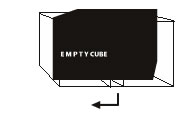MIGUEL PEREIRA E JOÃO RUIVO
NOVEMBER, 28, 2015

CONTACTS
Miguel Pereira check.miguel@gmail.com | João Ruivo joaoruivo@for-a.eu
EXHIBITION INFORMATION
Escuro3
performance
Photos: © Pedro Tropa
Volunteers:
Agapi Dimitriadou |
Alface Leitão |
André Uerba |
Beatrice Cordier |
Bruno Cadinha |
Claudia Canarim |
Inês Cartaxo |
Luara Moreira |
Lucie Lintanf |
Mafalda Ferraz |
Margarida Albino |
Nicola Carter |
Paulo Silva |
Pedro Nuñez |
Romain Teule |
Rui Almeida |
Sara Palácios |
Seraina Dejaco
A paradox, for a day
Cubed = one
In this edition of EMPTY CUBE, dancer and choreographer Miguel Pereira and architect João Ruivo / FORA (an association of architects founded in Athens, in 2009, by João Fagulha, Raquel Oliveira and João Ruivo: www.for-a.eu/) have created a fictitious connection between, on the one hand, the space and its uses and, on the other, the purposes and expectations that same space may contain and convey to each one of the viewers who took an active part in the work, as if they too were materials for the project.
“Escuro3” [Dark3], the title of this impermanent work, indirectly but sharply leads us into the relationship with the body, time and physical space that is typical of EMPTY CUBE, which, in this particular performative intervention, is suggestive of a party, announced by the music that enlessly echoes in a near-celebratory atmosphere.
The physical structure of EMPTY CUBE (the cube) was transferred to the entrance of Espaço Alkantara, in Lisbon, where it became something like a space between spaces whose entryway was changed by João Ruivo into a broken brick wall, suggestive of a structure that has been broken into, like a wall destroyed by burglars. On the other hand, however, the wall's blue polyurethane bricks have turned the space into something artificial, like a maquette or model, almost similar to a picture from a comic-book.
This passage gave access to the location of the party, announced by the music, in a playlist that featured only one track, which was repeated over the two hours that the project lasted, challenging all those who entered the cube's inner dark space to overcome the human hurdles that stood in the path of each visitor. The experience of the body, of its position in this space without coordinates, not forgetting the corporeality of the Other, male or female, led at first each individual into a tense and sometimes amusing experience, while Donna Summer's “I Feel Love” played on and on. The action of traversing this dark space, which could last a few seconds or minutes, depending on each spectator/participant, allowed them to reach the other side of the space once the black curtain was opened, revealing a closed glass wall the displayed the lights of a possible night club, endlessly throbbing to the aforementioned musical track. After coming there, visitors discovered a bar, where Bloody Mary shots were being served. Behind the counter, a figure dressed in black, wearing shades and a huge wig (like a pop star), incarnated one of the characters Miguel Pereira plays in some of his works, like for instance “Antonio Miguel”. The psychedelically-tinged atmosphere became a place for sharing what had been experienced between the itinerary that selected the body as its main object and the emotional sphere that enveloped it, in a constant contradiction between inhibition and amusement.
Everything in this project belongs in the realm of desire, fantasy and fiction. From the pierced wall, made of easily breakable materials, to the need to pass through unknown people, to the constantly repeated music and finally to the party, where a single drink was served. And then the return, once again back to the street. Once again the same sensorial and sensuous fun, with its contradictory tactile quality across a space where time is suspended and the memory of the experience becomes confused during a three-metre itinerary to the sound of a tune from the 1970s.
“I Feel Love” among hurdles that breathe and disturb us with their motions, remaining in the memory of the body even after the torn-down wall has been left behind. In the dark, cubed.
João Silvério
November 2015
O Rumo do Fumo e o Alkantara são estruturas financiadas pelo Ministério da Cultura/DGArtes.











